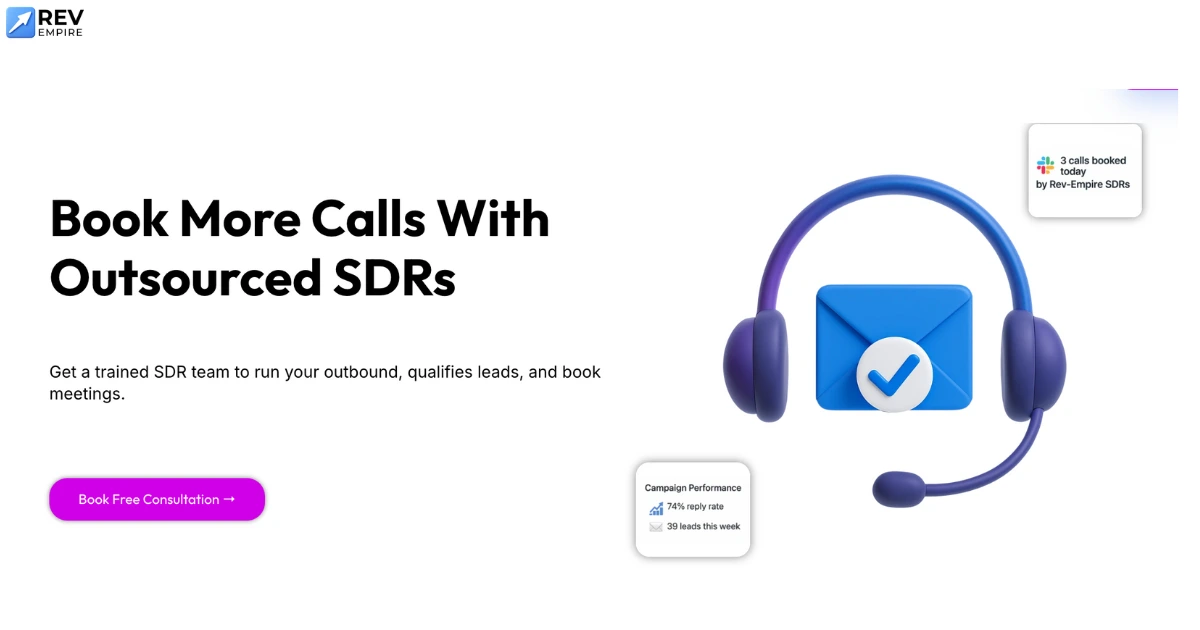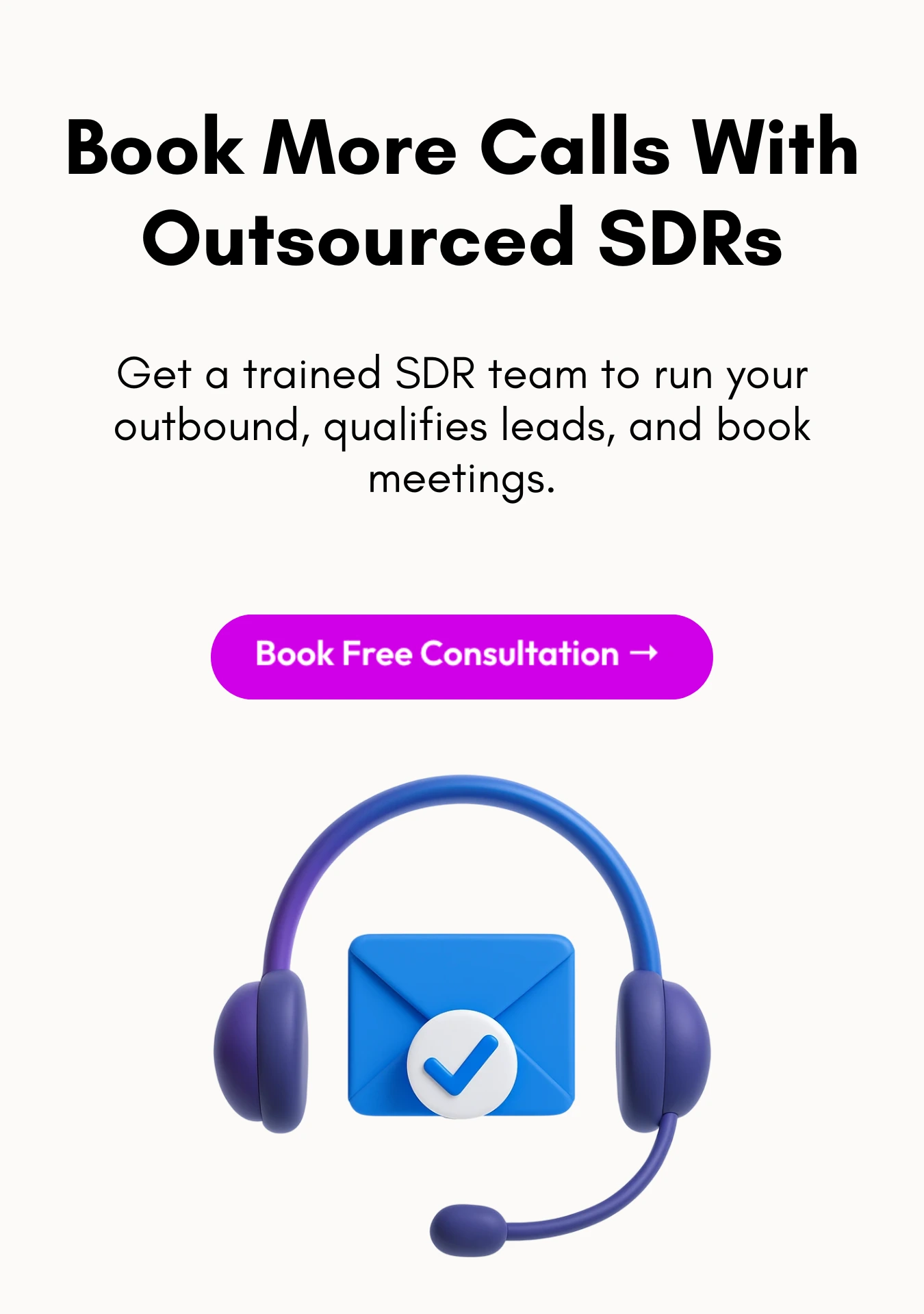In-House vs. Outsourced SDRs: Why CEOs Are Rethinking Their Approach

📅 Published: January 28, 2025 | ⏱️ 14–16 min read
Introduction
For many CEOs, outsourcing Sales Development Representatives (SDRs) feels like giving up control over a critical piece of the sales engine. Lead generation is deeply tied to revenue, so it’s no surprise that handing it over to an external team comes with concerns:- Will they understand our product and audience well enough to succeed?
- Can they uphold the tone and reputation of our brand?
- What happens if they don’t deliver quality leads? Will this cost us more in the long run?
Done right, outsourcing lets you tap into external expertise, increase efficiency, and enter new markets without overburdening your internal resources.In this comprehensive guide, we’ll address the common fears around outsourced SDRs, expose the often-ignored challenges of managing in-house SDR teams, pinpoint why some SDR outsourcing initiatives fall short, and most importantly, reveal how CEOs can make it work to unlock unparalleled scalable lead generation.
Running an In-House SDR Team: Challenges CEOs Can’t Ignore
Managing an in-house sales team gives you control over the process, no doubt. But let’s be honest—it comes with its share of headaches. From high turnover to slow onboarding and rising costs, these challenges can hold your business back, especially if you are trying to scale quickly. Let’s break it down.1. High turnover and burnout: The revolving door problem
The SDR role isn’t for the faint of heart. Making endless cold calls, sending dozens of outreach emails, and facing rejection day in and day out—it’s tough. Pair that with aggressive performance targets, and burnout becomes almost inevitable. Here’s what the data says:- The Average Tenure: Just 15 months.
- Attrition Rates: A whopping 34% of SDRs leave within their first year.
What high turnover costs you?
Let’s put this into perspective:- Recruiting and onboarding a single SDR costs $20,000–$30,000.
- Add in lost productivity while they ramp up, and the financial impact becomes even more painful.
- And don’t forget the strain on your existing team—fewer hands on deck means they are picking up the slack, which affects morale and performance.
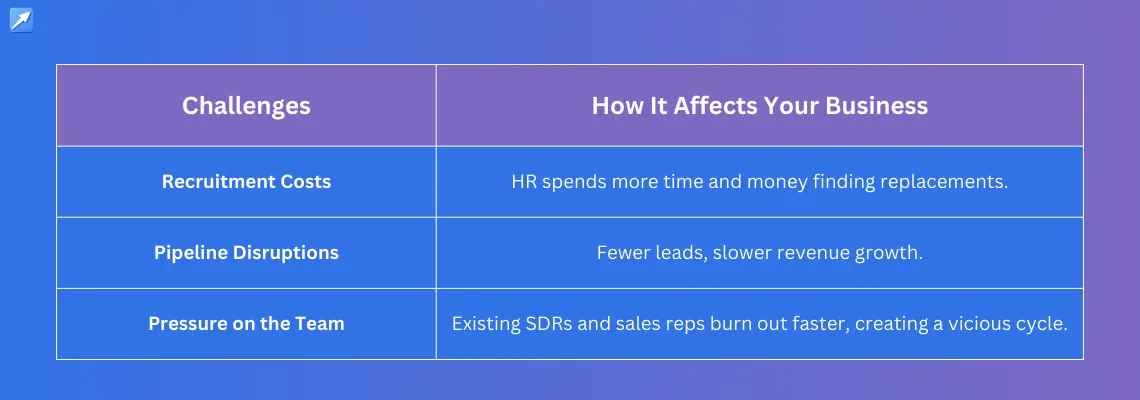
It’s not just a financial issue—it’s a momentum killer.
2. Slow ramp-up times: The hidden growth killer
Let’s say you have hired a new SDR. Great! But now, you’ve got to bring them up to speed. Onboarding isn’t a quick process—it takes an average of 3–4 months for an SDR to become fully productive.
And here’s the kicker: during this time, your pipeline slows down. Senior team members might step in to help train the new hire, which means they are spending less time closing deals. Suddenly, your entire sales engine feels like it’s running in slow motion.
Why ramp-up times hurt your business
- Delayed Revenue: You can’t hit your sales targets if the pipeline isn’t moving.
- Lost Opportunities: While your team is stuck onboarding, competitors may be snapping up opportunities you can’t pursue.
- Drain on Senior Staff: Instead of focusing on high-value deals, they are stuck mentoring and troubleshooting.
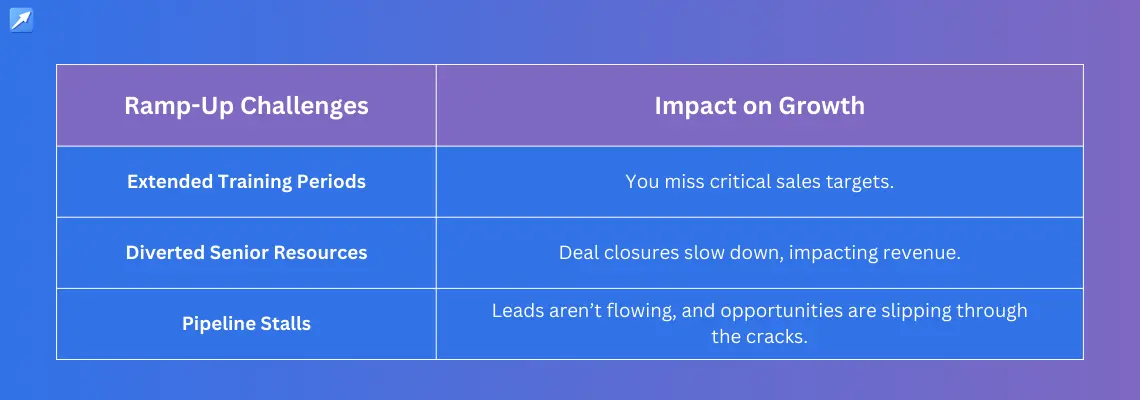
3. Escalating costs: It’s more than just salaries
Let’s talk money. On paper, SDRs might seem affordable—you are probably budgeting for their salary and commissions. But when you dig deeper, the actual cost is much higher.
Here’s a quick breakdown of what you are really spending:
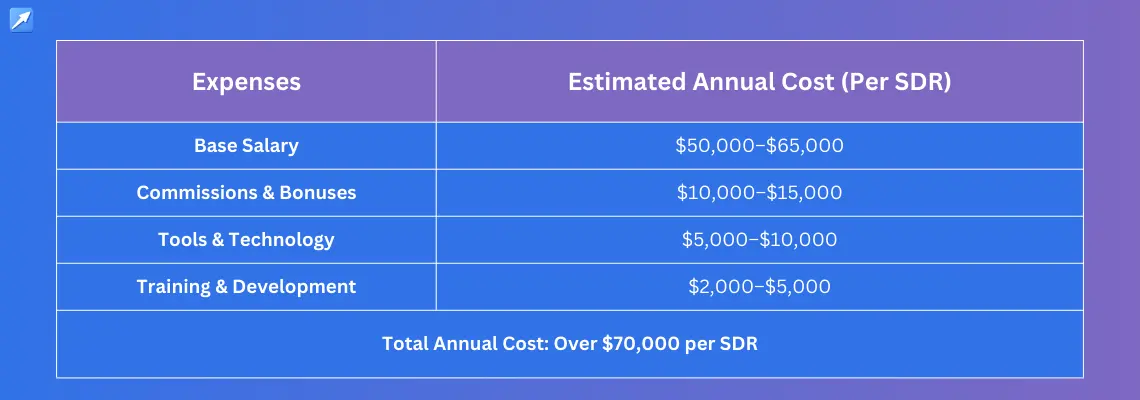
Now multiply that by your team size—and add turnover into the mix. It’s easy to see how these costs can spiral out of control, especially if you are dealing with frequent attrition.
4. Limited scalability: The growth bottleneck
Scaling an in-house SDR team isn’t as simple as flipping a switch. Recruiting, onboarding, and training new SDRs takes time—and by the time they are ready to perform, the opportunity you wanted to capture might have passed.
Why in-house teams struggle to scale
- Slow Recruitment Cycles: Finding the right SDRs takes months, which delays your ability to respond to market demands.
- High Overhead Costs: Growing your team means multiplying your expenses, leaving less room to invest in other growth strategies.
- Resource Bottlenecks: Your current team gets stretched thin during high-growth periods, which hurts productivity.
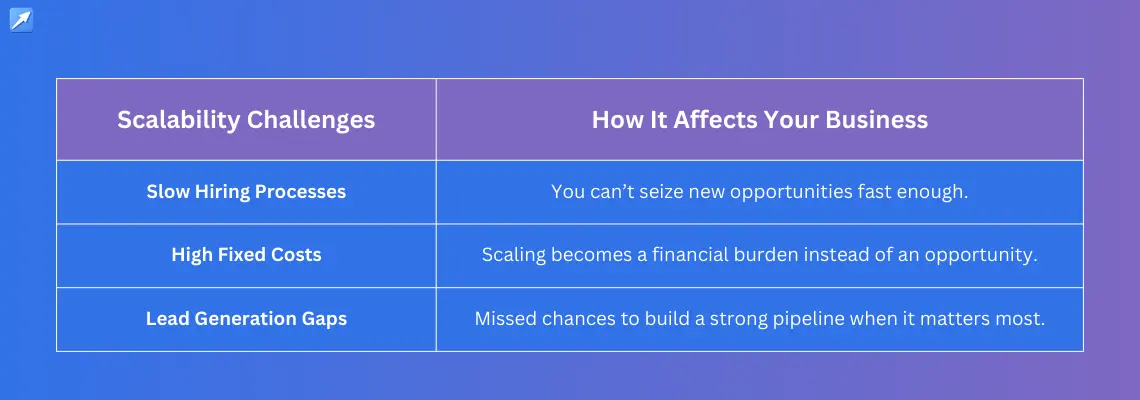
Key insights for CEOs
If you are trying to scale quickly, relying solely on an in-house SDR team can feel like running a marathon with ankle weights. It’s slow, it’s expensive, and it holds you back from achieving the growth you know your company is capable of.
Why outsourcing SDRs fails (And what CEOs get wrong)
Outsourcing SDRs is often seen as a way to bypass the challenges of managing in-house teams, but it’s not without risks. Many CEOs who attempt outsourcing end up disappointed with the results, leaving them skeptical of its effectiveness. A 2024 SaaStr report revealed that 93% of companies struggle to make outsourced SDRs work effectively.
So, why do so many outsourcing initiatives fall short? Let’s explore the common pitfalls and what CEOs often get wrong.
1. Lack of alignment with business goals
One of the biggest reasons outsourcing fails is a misalignment between the company’s goals and the outsourced team’s execution. When outsourced SDRs don’t have a clear understanding of your business strategy, it’s like asking someone to hit a target blindfolded.
Here’s what can go wrong:
- Undefined Ideal Customer Profiles (ICPs): Without a precise ICP, outsourced SDRs may waste time pursuing irrelevant leads.
- Inconsistent Messaging: Misaligned communication results in mixed messages that confuse prospects and dilute your brand.
- Overlapping Strategies: Lack of coordination between internal and outsourced teams can create duplication of efforts, leading to inefficiencies.
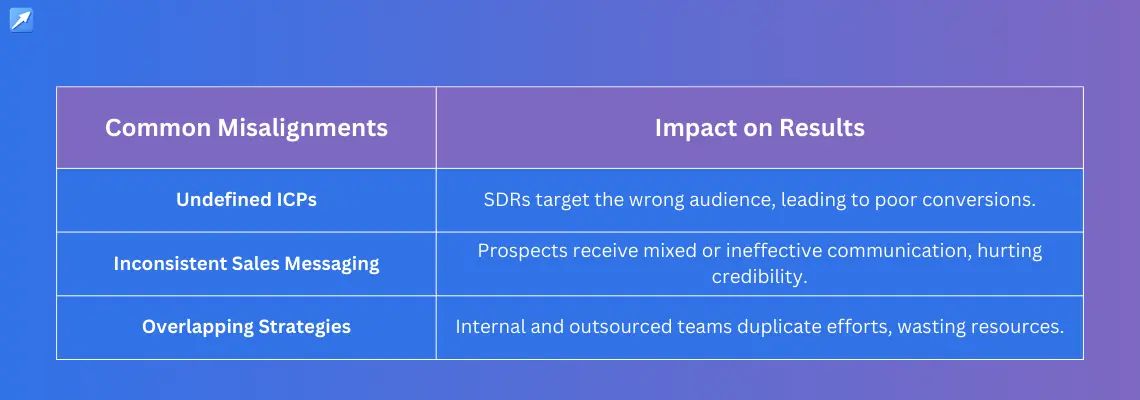
Why it happens
Outsourcing providers aren’t mind readers. If you don’t take the time to clearly communicate your ICP, sales strategy, and brand values, the results will reflect that. Without this foundation, even the most skilled SDRs will struggle to deliver meaningful outcomes.
2. Inadequate training and onboarding
Another common mistake is treating outsourced SDRs like external vendors rather than an extension of your team. When companies skip proper onboarding, they leave SDRs to fend for themselves, often relying on generic pitches and incomplete information.
What the numbers say
A 2024 Gartner report found that 67% of outsourced SDR failures stem from inadequate onboarding.
The impact
- SDRs lacking the right training often rely on surface-level scripts that fail to engage prospects.
- Prospects receive uninspired outreach that damages the company’s reputation.
- Low engagement rates lead to fewer qualified leads entering the pipeline.
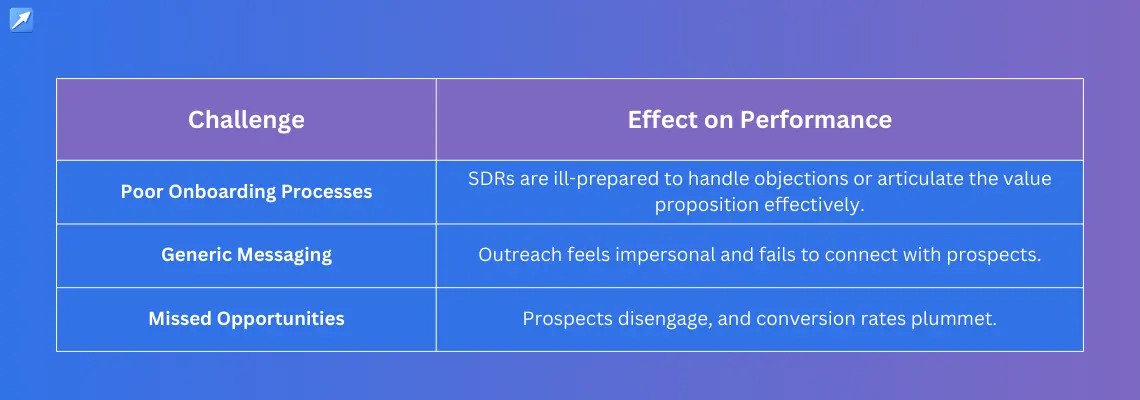
Why it happens
Many CEOs see outsourced SDRs as a “plug-and-play” solution, skipping essential steps like training on brand-specific messaging, product knowledge, or buyer personas. This lack of integration creates a disconnect between the SDR team and the company’s vision.
3. Overemphasis on quantity over quality
When it comes to outsourcing, some providers focus on delivering a high volume of leads to meet contractual obligations. While the numbers might look impressive on paper, it’s the quality of those leads that truly matters.
The pitfalls of focusing on quantity
- Low-Quality Leads: SDRs prioritize hitting volume targets rather than engaging with qualified prospects.
- Frustrated Sales Teams: Internal sales reps waste valuable time sifting through irrelevant or disengaged leads.
- Damaged Brand Reputation: Prospects who feel spammed or misled are unlikely to trust your company in the future.
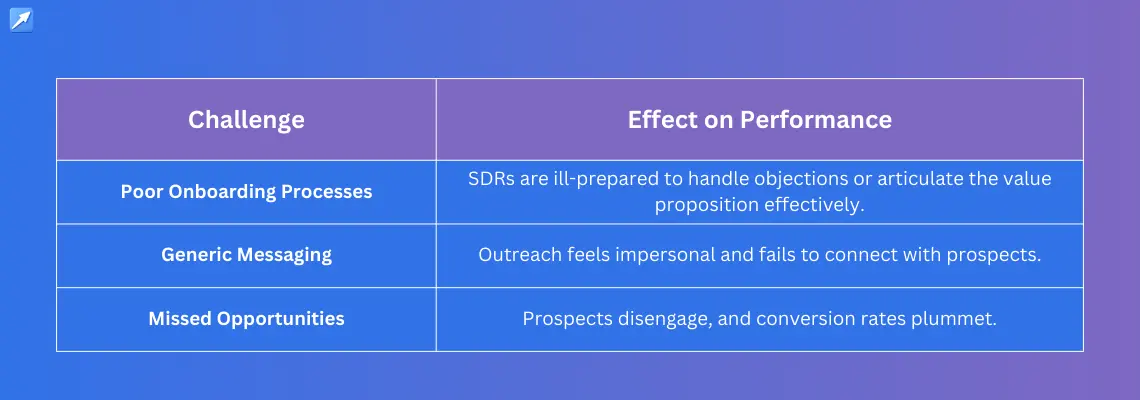
Why it happens
Some outsourcing providers operate on a “more is better” mindset, prioritizing metrics like the number of leads generated over the quality of those leads. This approach doesn’t just waste resources—it also creates friction within your internal sales team.
4. The “set-it-and-forget-It” mentality
Outsourcing SDRs isn’t a hands-off solution, but many CEOs fall into the trap of disengaging after hiring an external team. They assume the outsourcing provider will take care of everything, only to discover that the results don’t align with their evolving strategy.
What goes wrong
- Lack of regular communication creates a disconnect between the outsourced team and the company’s shifting goals.
- Feedback loops are nonexistent, so SDRs continue using ineffective strategies without course correction.
- The outsourced team becomes isolated, losing sight of the company’s vision and values.
Key Takeaway
Outsourcing works best when treated as a partnership, not a transaction. Success requires active involvement, including:
- Regular Check-Ins: Keep the lines of communication open to ensure alignment with goals.
- Feedback Loops: Provide actionable insights to help the outsourced team improve.
- Shared Metrics: Collaborate on KPIs to measure success and adjust as needed.
Key insights for CEO
Outsourcing SDRs can be a game-changer—but only if done thoughtfully. Misalignment, poor onboarding, an overemphasis on quantity, and a lack of collaboration are the most common reasons these efforts fail.
To make outsourcing work, CEOs need to stay engaged, communicate clearly, and treat the external team as a true extension of their business. When approached strategically, outsourcing can overcome the challenges of in-house teams and drive scalable growth.
When should CEOs outsource SDRs?
Outsourcing SDRs isn’t a one-size-fits-all solution. It doesn’t work for every business, but when the conditions are right, it can be a powerful tool to drive growth and efficiency. So, how do you know when to outsource? And more importantly, how do you make it work? Let’s break it down.
Outsourcing makes the most sense when your business is at a pivotal moment—scaling rapidly, entering new markets, or trying to optimize resources. Here are some scenarios where outsourcing can deliver the most value:
1. Scaling quickly
If sales opportunities are outpacing your internal capacity, outsourcing can help you bridge the gap. Outsourced SDR teams can hit the ground running in weeks, providing immediate support to fuel lead generation without the delays of hiring and onboarding.
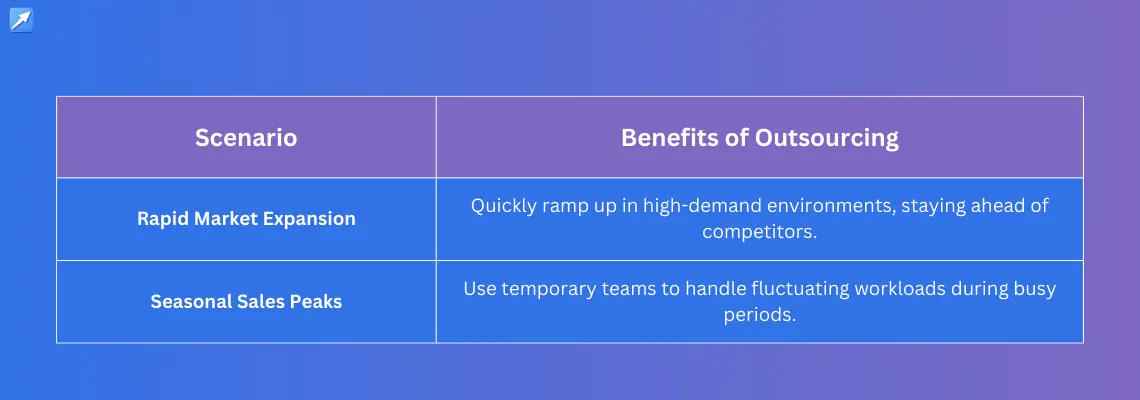
2. Entering new markets
Expanding into unfamiliar territories—whether geographic regions or new industries—requires specialized knowledge. Outsourced SDR teams often have the local expertise, tools, and processes to accelerate market entry with less risk.

3. Freeing up internal teams
Your internal sales team should be laser-focused on what they do best: nurturing and closing high-value deals. By outsourcing prospecting tasks to an external team, you can free up their time to drive more significant revenue opportunities.
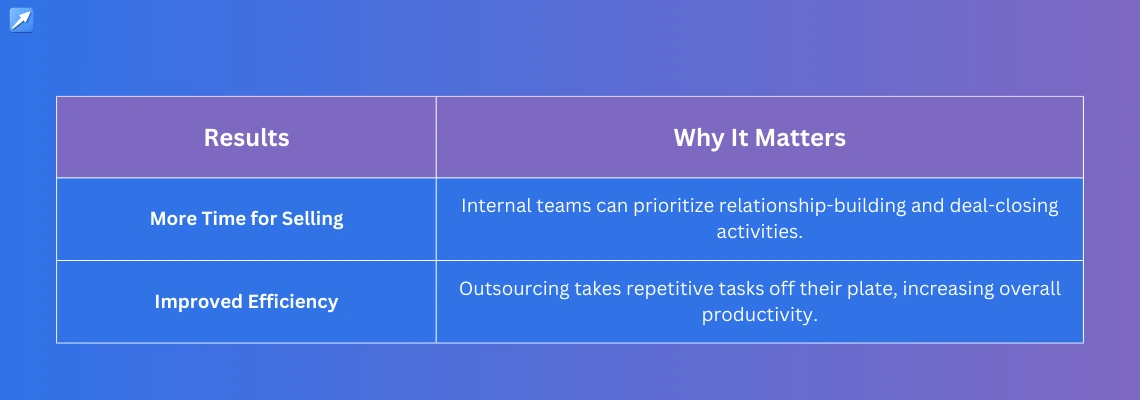
4. Reducing costs
Building and maintaining an in-house SDR team is expensive—salaries, benefits, recruitment, and training all add up. Outsourcing allows you to skip those overheads and pay only for results, making it a cost-effective option for scaling.

How to make outsourcing SDRs work?
Outsourcing only works when approached strategically. It’s not just about picking a provider and hoping for the best—it requires thoughtful planning, clear communication, and ongoing collaboration. Here’s how to get it right:
1. Invest in comprehensive onboarding
Treat outsourced SDRs as an extension of the internal team. The more they understand your business, the better they can represent your brand. A strong onboarding process includes detailed training on your Ideal Customer Profile (ICP), product knowledge, and sales strategies.
SDRs should be familiar with your messaging, tone, and positioning to ensure consistency in outreach and engagement.The smoother the onboarding, the faster they can start delivering results.
2. Define clear KPIs
Setting clear, measurable goals is critical to evaluating the success of your outsourced SDR team. Instead of focusing solely on the number of leads generated, prioritize metrics that reflect lead quality and long-term business impact.
Track SQL conversion rates to ensure a focus on high-intent prospects. Monitor pipeline growth and revenue contribution to gauge overall sales effectiveness. Clearly defined KPIs keep outsourced teams aligned with your expectations and business objectives.
3. Foster continuous collaboration
Outsourcing sales isn’t a “set-it-and-forget-it” approach. Regular collaboration between your internal and outsourced teams ensures that strategies remain aligned and results improve over time. Utilize shared tools like CRMs and dashboards to maintain transparency and real-time visibility into performance. Schedule frequent check-ins to review progress, address challenges, and refine outreach strategies. A strong feedback loop enhances adaptability and ensures your SDR team remains effective in an evolving market.
4. Choose the right partner
Not all outsourcing providers are created equal. Selecting the right partner can make or break your outsourced SDR strategy. Look for firms with deep industry experience and a proven track record of success in your niche. Ensure they provide transparent reporting so you always have insight into performance and optimization opportunities. Most importantly, prioritize a partner focused on quality over quantity—delivering high-value leads instead of just inflating numbers.
Takeaway for CEOs
Outsourcing SDRs can be a game-changing strategy for scaling, entering new markets, and optimizing resources. But it’s not a shortcut—you’ll only succeed if you approach it thoughtfully. By investing in onboarding, setting clear KPIs, fostering collaboration, and choosing the right partner, you can unlock the full potential of outsourcing and drive sustainable growth for your business.
The future of SDR outsourcing: Trends CEOs need to watch
The way businesses approach SDR outsourcing is evolving rapidly. Technology is advancing, workplace dynamics are shifting, and buyer expectations are higher than ever. For CEOs, staying informed about these changes isn’t just helpful—it’s critical for making decisions that align with the future of sales.
Here’s a closer look at what’s changing in SDR outsourcing and what it means for your business.
1. AI-driven SDR processes
Artificial intelligence (AI) has moved from being a buzzword to a practical tool for SDR teams, transforming how lead generation and prospecting are done. The integration of AI isn’t about replacing human SDRs; it’s about enhancing their efficiency and enabling them to focus on what they do best: building connections.
What’s changing?
- Finding the Right Leads: AI tools can analyze large datasets to identify leads that are most likely to convert. This means SDRs can focus their energy on prospects who already have a high chance of engaging.
- Smarter Conversations: Tools like conversational AI can handle the initial stages of outreach—asking basic questions, gathering data, and qualifying leads. By the time the SDR steps in, the prospect is already warm.
- Personalized Messaging: AI can help tailor outreach by analyzing a prospect’s behavior, preferences, and interactions with your brand.
Why it matters
AI doesn’t just save time; it improves results. A McKinsey report found that businesses using AI for sales saw a 20% higher lead conversion rate compared to those relying solely on manual methods. For companies that outsource SDR work, this means providers who use AI effectively can deliver better-quality leads faster, making every dollar count.
2. The rise of remote SDR teams
Remote work is here to stay, and it’s changing the way outsourcing works. Today, outsourced SDR teams often operate entirely remotely, giving businesses access to talent across the globe without being tied to a single location.
The benefits
- Global Talent: Need SDRs who understand a specific region, language, or culture? Remote teams make it easier to find the right people, no matter where they’re based.
- Cost Savings: Without the need for physical office space, remote SDR teams are often more affordable. Plus, businesses can scale up or down without long-term commitments.
- Flexibility: Remote teams can quickly adapt to your changing needs, whether you’re expanding into a new market or navigating seasonal sales spikes.
The challenges
Of course, managing remote teams isn’t without its hurdles. Communication gaps, unclear expectations, and inadequate tools can all hinder performance. This means companies need to invest in the right systems—like CRM platforms and shared dashboards—to ensure that outsourced teams stay connected and productive.
Why CEOs should care
The shift toward remote work isn’t just a trend—it’s the future of outsourcing. Companies that embrace remote SDR teams gain access to a much broader talent pool and can move faster when entering new markets or scaling operations.
3. The Push for hyper-personalization
Buyers today expect more than just a generic pitch—they want to feel like you understand their unique needs and challenges. For outsourced SDRs, this means moving beyond scripts and using data to create truly personalized outreach.
What this looks like
- Detailed Buyer Personas: SDRs are armed with in-depth profiles that outline a prospect’s role, goals, and pain points.
- Real-Time Insights: Tools track a prospect’s interactions with your website, emails, and content, allowing SDRs to time their outreach perfectly.
- Tailored Messaging: Instead of sending the same email to everyone, SDRs craft messages that speak directly to the prospect’s situation.
Why it works
A HubSpot study found that hyper-personalized outreach increases response rates by 30%. Prospects are more likely to engage with messages that feel relevant and thoughtful, which means fewer wasted opportunities and more meaningful conversations.
4. Sustainability Is becoming a priority
Outsourcing decisions aren’t just about cost or efficiency anymore—sustainability is starting to play a bigger role. As more businesses adopt Environmental, Social, and Governance (ESG) goals, they’re looking for outsourcing providers who share those values.
What CEOs are considering
- Eco-Friendly Practices: Companies are favoring providers who minimize their environmental impact, whether that’s through remote work or energy-efficient operations.
- Fair Labor Standards: Ethical labor practices are becoming a non-negotiable for many businesses.
- Alignment with Company Values: Outsourcing partners need to reflect the company’s own commitment to sustainability and social responsibility.
Why it matters
Sustainability isn’t just about doing the right thing—it’s becoming a business necessity. Customers, employees, and investors are increasingly drawn to companies that prioritize ethical practices. By choosing SDR outsourcing providers who align with these values, businesses can strengthen their reputation and build stronger relationships with stakeholders.
Takeaway for CEOs:
The future of SDR outsourcing is about more than just finding a cost-effective way to generate leads. It’s about staying ahead of the curve and making choices that position your business for long-term success.
Here’s what to focus on:
- Embrace AI: Look for providers who use AI to enhance lead generation and outreach. The efficiency and results speak for themselves.
- Think Global: Remote SDR teams give you access to top talent from around the world, helping you scale and enter new markets with ease.
- Prioritize Personalization: Ensure that outsourced SDRs are equipped to deliver hyper-personalized experiences that resonate with today’s buyers.
- Align on Values: Choose providers who share your sustainability and ethical commitments, reinforcing your brand’s reputation and appeal.
By paying attention to these trends, you’re not just outsourcing SDR work—you’re building a smarter, more resilient sales strategy that’s ready for whatever the future holds.
Conclusion
Outsourcing SDRs isn’t just about getting tasks off your internal team’s plate; it’s about focusing your energy where it matters most for revenue growth. It’s about empowering your internal sales team with qualified leads, giving them the time and space to close more deals, explore new markets, and build truly meaningful, long-term relationships with customers.
At Rev-Empire, we understand that embracing outsourced sales development can feel like a significant leap. That’s precisely why we dedicate ourselves to making it as seamless, effective, and transparent as possible. We invest heavily in understanding your unique goals, aligning precisely with your vision, and delivering predictable, scalable lead generation results that truly move your needle.
If you are a CEO ready to simplify your sales process, overcome in-house SDR challenges, and scale with confidence through a strategic, balanced approach, we are here to help.
Don’t let in-house SDR challenges stifle your growth. If you’re ready to embrace a smarter, more scalable lead generation strategy that balances innovation with the human touch, schedule a free strategy session with Rev-Empire today! Let us help you unlock predictable revenue.
Categories
Recent posts
Share on socials
FAQs about in-house vs. outsourced SDRs
What kind of ROI can I expect from investing in outsourced SDRs?
The ROI from outsourced SDRs can be substantial, primarily due to increased efficiency, reduced operational costs, and faster market penetration. You can expect to see improved lead quality, higher conversion rates from MQL to SQL, a more predictable sales pipeline, and a lower cost per qualified lead. By offloading recruiting, training, and management overhead, you significantly reduce fixed costs and gain a more agile, scalable sales development function. Many businesses report achieving positive ROI within the first 3-6 months, often driven by the ability to rapidly scale qualified lead generation.
How quickly can an outsourced SDR team be up and running for my business?
One of the primary advantages of outsourced SDRs is speed. While building an in-house team can take 3-6 months (or more) for hiring, onboarding, and ramp-up to full productivity, a specialized outsourced team can often be integrated and actively generating leads within 2-4 weeks. This rapid deployment allows your business to seize market opportunities faster, accelerate pipeline growth, and quickly respond to fluctuating demand without the typical delays associated with internal hiring.
What is the process for onboarding and integrating an outsourced SDR team with my existing sales operations?
The integration process is designed to be seamless. It typically begins with an in-depth discovery phase where the outsourced provider thoroughly understands your Ideal Customer Profile (ICP), product, brand voice, and specific sales goals. This is followed by a comprehensive training program for the SDRs, immersing them in your company culture, messaging, and sales methodologies. Integration with your existing CRM and sales tech stack ensures transparent communication and data flow. Regular collaborative meetings, shared dashboards, and continuous feedback loops ensure the outsourced team acts as a true extension of your sales operations. To learn more about our specific, proven process for successful integration, visit our Outsourced SDR Services page.
How do you ensure the outsourced SDR team truly understands our product and brand voice?
Ensuring deep product and brand understanding is critical for successful outsourcing. Reputable providers achieve this through rigorous, customized onboarding and ongoing training. This includes dedicated sessions on your product’s features, benefits, and competitive differentiators, as well as workshops on your brand’s unique tone, values, and messaging guidelines. Regular calibration calls, call shadowing, and feedback sessions are also vital to ensure consistent, high-quality representation that aligns perfectly with your brand’s reputation and strategic objectives.
Is outsourced SDR suitable for businesses of all sizes, including startups?
Yes, outsourced SDR can be highly beneficial for businesses of all sizes, from agile startups to large enterprises. For startups and SMEs, it offers a cost-effective way to access experienced sales development talent and scale rapidly without the significant overhead and risks of building an internal team from scratch. For larger enterprises, it can provide specialized expertise for new market entry, accelerate pipeline growth for specific products, or simply free up valuable internal resources to focus on core closing activities. Its flexibility makes it adaptable to diverse business needs and growth stages.

